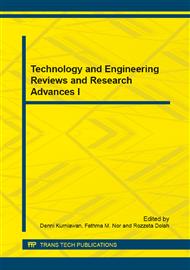[1]
Jenness, V., D.A. Smith, and J. Stepan-Norris, Editors' Note: Taking a Look at Surveillance Studies. Contemporary Sociology: A Journal of Reviews, 2007. 36(2): p. vii-viii.
DOI: 10.1177/009430610603600201
Google Scholar
[2]
Chen, W.T., et al. Design and implementation of a real time video surveillance system with wireless sensor networks. 2008: IEEE.
Google Scholar
[3]
Tasaki, T., et al., A GIS-based zoning of illegal dumping potential for efficient surveillance. Waste Management, 2007. 27(2): pp.256-267.
DOI: 10.1016/j.wasman.2006.01.018
Google Scholar
[4]
Kirchner, R., Surveillance and Threat Detection: Prevention versus Mitigation. 2013: Butterworth-Heinemann.
Google Scholar
[5]
Farmer, A., Handbook of environmental protection and enforcement: Principles and practice. 2007: Earthscan.
Google Scholar
[6]
International Network for Environmental Compliance and Enforcement (INECE), Principles of Environmental Compliance and Enforcement Handbook. 2009, Washington: INECE.
Google Scholar
[7]
Yu, C.Y., Environmental Monitoring and Audit in Putrajaya Development, in Environmental Management in Construction - Putrajaya's Experience. 2000: Bangi, Malaysia.
Google Scholar
[8]
May, P. and S. Winter, Regulatory enforcement and compliance: Examining Danish agro‐environmental policy. Journal of Policy Analysis and Management, 1999. 18(4): pp.625-651.
DOI: 10.1002/(sici)1520-6688(199923)18:4<625::aid-pam5>3.0.co;2-u
Google Scholar
[9]
Alsharif, K., Construction and stormwater pollution: Policy, violations, and penalties. Land Use Policy, 2010. 27(2): pp.612-616.
DOI: 10.1016/j.landusepol.2009.08.002
Google Scholar
[10]
European Union Network for the Implementation and Enforcement of Environmental Law (IMPEL), IMPEL Reference Book for Environmental Inspection. 1999, Netherlands.
DOI: 10.46850/elni.2005.008
Google Scholar
[11]
Chen, Y. and J.M. Kamara, A framework for using mobile computing for information management on construction sites. Automation in Construction, 2011. 20(7): pp.776-788.
DOI: 10.1016/j.autcon.2011.01.002
Google Scholar
[12]
Damian, C., C. Fosalau, and C. Zet. Wireless Communication System for Environmental Monitoring. (2007).
Google Scholar
[13]
Mohamad, R.H. and A. Aripin. Issues and Challenges in Environmental Monitoring and Enforcement in Sabah. in Fourth Sabah-Sarawak Environmental Convention 2006. 2006. Kota Kinabalu Sabah, Malaysia: Chief Minister's Department, Sabah and Environment Protection Department, Sabah.
DOI: 10.17485/ijst/2017/v10i13/112975
Google Scholar
[14]
Vivoni, E.R. and R. Camilli, Real-time streaming of environmental field data. Computers & Geosciences 2003. 29 (2003) p.457–468.
DOI: 10.1016/s0098-3004(03)00022-0
Google Scholar
[15]
Kim, Y.S., et al., A PDA and wireless web-integrated system for quality inspection and defect management of apartment housing projects. Automation in Construction, 2008. 17 (2008): pp.163-179.
DOI: 10.1016/j.autcon.2007.03.006
Google Scholar
[16]
Cheung, S.O., K.K.W. Cheung, and H.C.H. Suen, CSHM: Web-based safety and health monitoring system for construction management. Journal of Safety Research, 2004. 35(2): pp.159-170.
DOI: 10.1016/j.jsr.2003.11.006
Google Scholar
[17]
Martinez, K., J.K. Hart, and R. Ong, Environmental sensor networks. Computer, 2004. 37(8): pp.50-56.
Google Scholar
[18]
Xiang-zheng, D., et al., Internet based environmental monitoring information system and its application in Yili Prefecture. Journal of Geographical Sciences, 2002. 12(2): pp.163-170.
DOI: 10.1007/bf02837470
Google Scholar
[19]
Bowden, S., et al., Mobile ICT support for construction process improvement. Automation in Construction, 2006. 15(5): pp.664-676.
DOI: 10.1016/j.autcon.2005.08.004
Google Scholar
[20]
Bowden, S.L., Application of mobile IT in construction. 2005, © Sarah Louise Bowden.
Google Scholar
[21]
Chen, Y. and J.M. Kamara. The use of mobile computing in construction information management. in Proceedings of the 21st Annual Conference of the Association of Researchers in Construction Management (ARCOM) SOAS, London. (2005).
Google Scholar
[22]
Chen, Y. and J.M. Kamara, Using mobile computing for construction site information management. Engineering, construction and architectural management, 2008. 15(1): pp.7-20.
DOI: 10.1108/09699980810842034
Google Scholar
[23]
Irizarry, J. and T. Gill. Mobile applications for information access on construction jobsites. in International Workshop on Computing in Civil Engineering. 2009: ASCE.
DOI: 10.1061/41052(346)18
Google Scholar
[24]
Cox, S., J. Perdomo, and W. Thabet. Construction field data inspection using pocket PC technology. in International Council for Research and Innovation in Building and Construction, CIB w78 conference. (2002).
Google Scholar
[25]
Barrenetxea, G., et al. Wireless sensor networks for environmental monitoring: The sensorscope experience. 2008: IEEE.
Google Scholar
[26]
Akyildiz, I.F., et al., Wireless sensor networks: a survey. Computer Networks, 2002. 38(4): pp.393-422.
DOI: 10.1016/s1389-1286(01)00302-4
Google Scholar
[27]
Kazem Sohraby, Daniel Minoli, and Taieb Znati, Wireless Sensor Networks: Technology, Protocols, and Applications. 2007, New Jersey: John Wiley & Sons, Inc.
DOI: 10.1002/047011276x
Google Scholar
[28]
Zúniga, M. and B. Krishnamachari, Integrating future large-scale wireless sensor networks with the internet. USC Computer Science, Tech. Rep, (2003).
Google Scholar
[29]
Ghobakhlou, A., S. Zandi, and P. Sallis, Development of environmental monitoring system with wireless sensor networks. (2011).
Google Scholar
[30]
Santini, S., B. Ostermaier, and A. Vitaletti. First experiences using wireless sensor networks for noise pollution monitoring. in Proceedings of the workshop on Real-world wireless sensor networks. 2008: ACM.
DOI: 10.1145/1435473.1435490
Google Scholar
[31]
Brüel & Kjær UK Ltd. Carry Online With Interactive Sound Level Meters. 2014 12th March 2014]; Available from: http: /www. bksv. co. uk/newsevents/news/unitedkingdom/2250%20online.
Google Scholar
[32]
Telefónica I+D. Smart Santander Project. 2014 14th March 2014]; Available from: http: /www. smartsantander. eu.
Google Scholar
[33]
M4D Impact. The EkoBus Project. 2014 14th March 2014]; Available from: https: /mobiledevelopmentintelligence. com/products/3138-ekobus-project.
Google Scholar
[34]
Bergdahl, I., et al., Increased mortality in COPD among construction workers exposed to inorganic dust. European Respiratory Journal, 2004. 23(3): pp.402-406.
DOI: 10.1183/09031936.04.00034304
Google Scholar
[35]
Dement, J.M., et al., Airways obstruction among older construction and trade workers at Department of Energy nuclear sites. American journal of industrial medicine, 2010. 53(3): pp.224-240.
DOI: 10.1002/ajim.20792
Google Scholar
[36]
Lee, C. -Y., et al., An efficient continuous tracking system in real-time surveillance application. Journal of Network and Computer Applications, 2011(0).
Google Scholar


